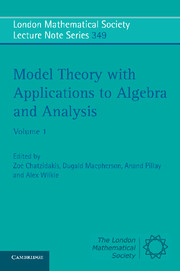Book contents
- Frontmatter
- Contents
- Preface
- Contributors
- Model theory and stability theory, with applications in differential algebra and algebraic geometry
- Differential algebra and generalizations of Grothendieck's conjecture on the arithmetic of linear differential equations
- Schanuel's conjecture for non-isoconstant elliptic curves over function fields
- An afterthought on the generalized Mordell-Lang conjecture
- On the definitions of difference Galois groups
- Differentially valued fields are not differentially closed
- Complex analytic geometry in a nonstandard setting
- Model theory and Kähler geometry
- Some local definability theory for holomorphic functions
- Some observations about the real and imaginary parts of complex Pfaffian functions
- Fusion of structures of finite Morley rank
- Establishing the o-minimality for expansions of the real field
- On the tomography theorem by P. Schapira
- A class of quantum Zariski geometries
- Model theory guidance in number theory?
Some observations about the real and imaginary parts of complex Pfaffian functions
Published online by Cambridge University Press: 04 August 2010
- Frontmatter
- Contents
- Preface
- Contributors
- Model theory and stability theory, with applications in differential algebra and algebraic geometry
- Differential algebra and generalizations of Grothendieck's conjecture on the arithmetic of linear differential equations
- Schanuel's conjecture for non-isoconstant elliptic curves over function fields
- An afterthought on the generalized Mordell-Lang conjecture
- On the definitions of difference Galois groups
- Differentially valued fields are not differentially closed
- Complex analytic geometry in a nonstandard setting
- Model theory and Kähler geometry
- Some local definability theory for holomorphic functions
- Some observations about the real and imaginary parts of complex Pfaffian functions
- Fusion of structures of finite Morley rank
- Establishing the o-minimality for expansions of the real field
- On the tomography theorem by P. Schapira
- A class of quantum Zariski geometries
- Model theory guidance in number theory?
Summary
Introduction
The main result of this paper has a simple proof, but is a central component in a large-scale project I have recently completed on the model theory of elliptic functions [7, 8]. In that project I take up important work of Bianconi [2] from around 1990, on the Weierstrass ℘ functions on an appropriate domain, and carry it to a decidability result modulo André's conjecture on 1-motives [1]. Bianconi proved model-completeness results, nonconstructively, for the basic situation, and I can see no way to constructivize the method he uses. Instead, I use ideas from two major developments subsequent to Bianconi's work, namely the work of Wilkie [10] and Macintyre-Wilkie [9], and the work of Gabrielov [4] and Gabrielov-Vorobjov [5]. To link with these papers, I interpret Bianconi's formulations in one based on taking the compositional inverse ℘−1, on an appropriate compact, as primitive. The latter function, in contrast to ℘, is complex Pfaffian, and this alone yields, by a result of Gabrielov [5] an important constructive multiplicity bound. But I need more, namely that the real and imaginary parts of ℘−1 are real Pfaffian and this is what I prove below. I doubt that there is any nontrivial general result allowing one to deduce that the real and imaginary parts of a complex Pfaffian function are real Pfaffian, and it is for this reason that I choose to publish the simple, useful result below.
- Type
- Chapter
- Information
- Model Theory with Applications to Algebra and Analysis , pp. 215 - 224Publisher: Cambridge University PressPrint publication year: 2008
- 5
- Cited by



